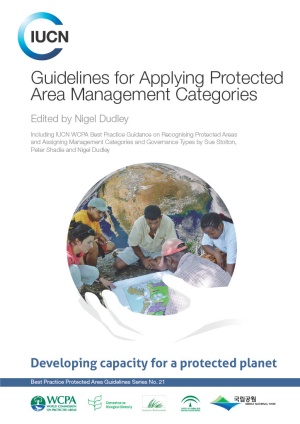Guidelines for Applyed Protected Area Management Categories |
Content:
Background
Protected areas
History of the IUCN protected area categories
Purpose of the IUCN protected area management categories
2. Definition and categories
The new IUCN definition of a protected area
Principles
Definition of a protected area system and the ecosystem approach
Categories
Objectives common to all six protected area categories
Category Ia: Strict nature reserve
Category Ib: Wilderness area
Category II: National park
Category III: Natural monument or feature
Category IV: Habitat/species management area
Category V: Protected landscape/seascape
Category VI: Protected area with sustainable use of natural resources
Relationship between the categories
3. Governance
Governance of protected areas
Governance by indigenous peoples and local communities
Private governance
4. Applying the categories
Choosing the correct category
Assignment
Reporting
Strengthening the assignment of categories
5. Using the categories
Using the IUCN protected area categories as a tool for conservation planning
Planning for climate change
Using the IUCN protected area categories as a tool for conservation policy
6. Specialized applications
Forest protected areas
Marine protected areas
Inland water protected areas
Sacred natural sites
Geodiversity
Restoration and IUCN protected area categories
7. International conservation initiatives
World Heritage Convention
Ramsar Convention
Convention on Biological Diversity
8. Effectiveness of the IUCN categories
Assessment of management and the IUCN categories
Appendix. Typology and glossary
References
Tables
1. Explanation of protected area definition
2. “National parks” in various categories
3. “The IUCN protected area matrix”: a classification system for protected areas comprising both management
category and governance type
4. How size of protected area relates to the category
5. Strength-Weakness-Opportunity-Threat analysis for categories under climate change
6. Examples of Forest Protected Areas, and also of well conserved forests that are not Forest Protected Areas
7. Distinguishing connectivity conservation areas such as biological corridors, stepping-stones and buffer zones
inside and outside protected areas
8. Categorization of the Great Barrier Reef
9. Application of categories in marine protected areas
10. Examples of protected areas in different categories providing benefits to inland waters
11. Compatibility of various inland water protection strategies with IUCN categories
12. Most appropriate protected area categories for different types of inland wetland ecosystems
13. Examples of sacred sites in IUCN categories
14. Examples of geodiversity in different IUCN protected area categories
15. Indications of suitable IUCN protected area categories for different aspects of geodiversity
16. Indicative guide to restoration in different IUCN categories
17. Changing relationship between natural World Heritage sites and protected areas over time
18. Elements of the WCPA framework for assessing management effectiveness of protected areas
19. Definition of terms used in the guidelines
Figures
1. Naturalness and IUCN protected area categories
2. Zones and IUCN protected area categories
3. Process for assigning protected area categories
4. Frequency of IUCN PA categories occurrence in biodiversity and non-biodiversity natural WH sites
Download Publication

